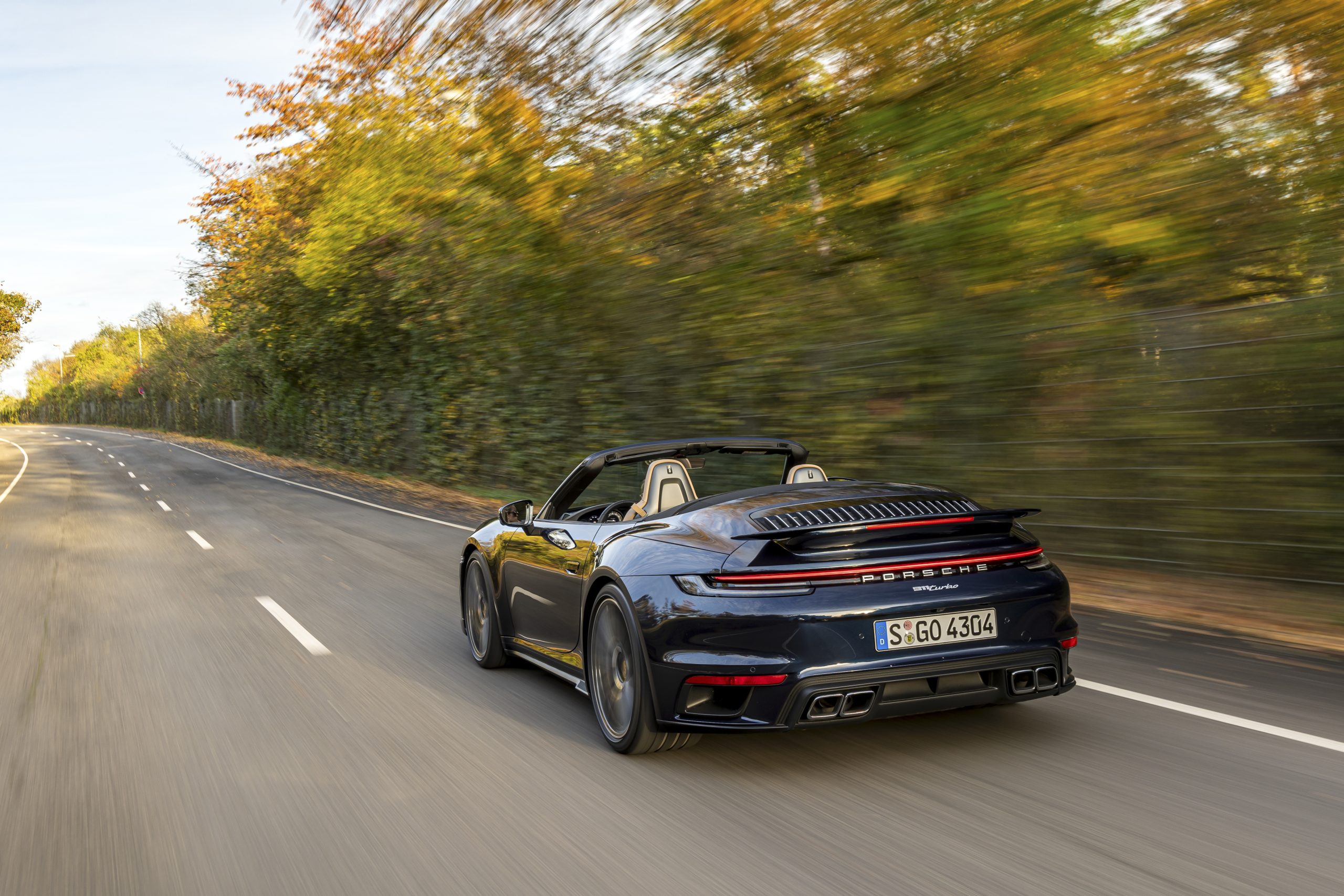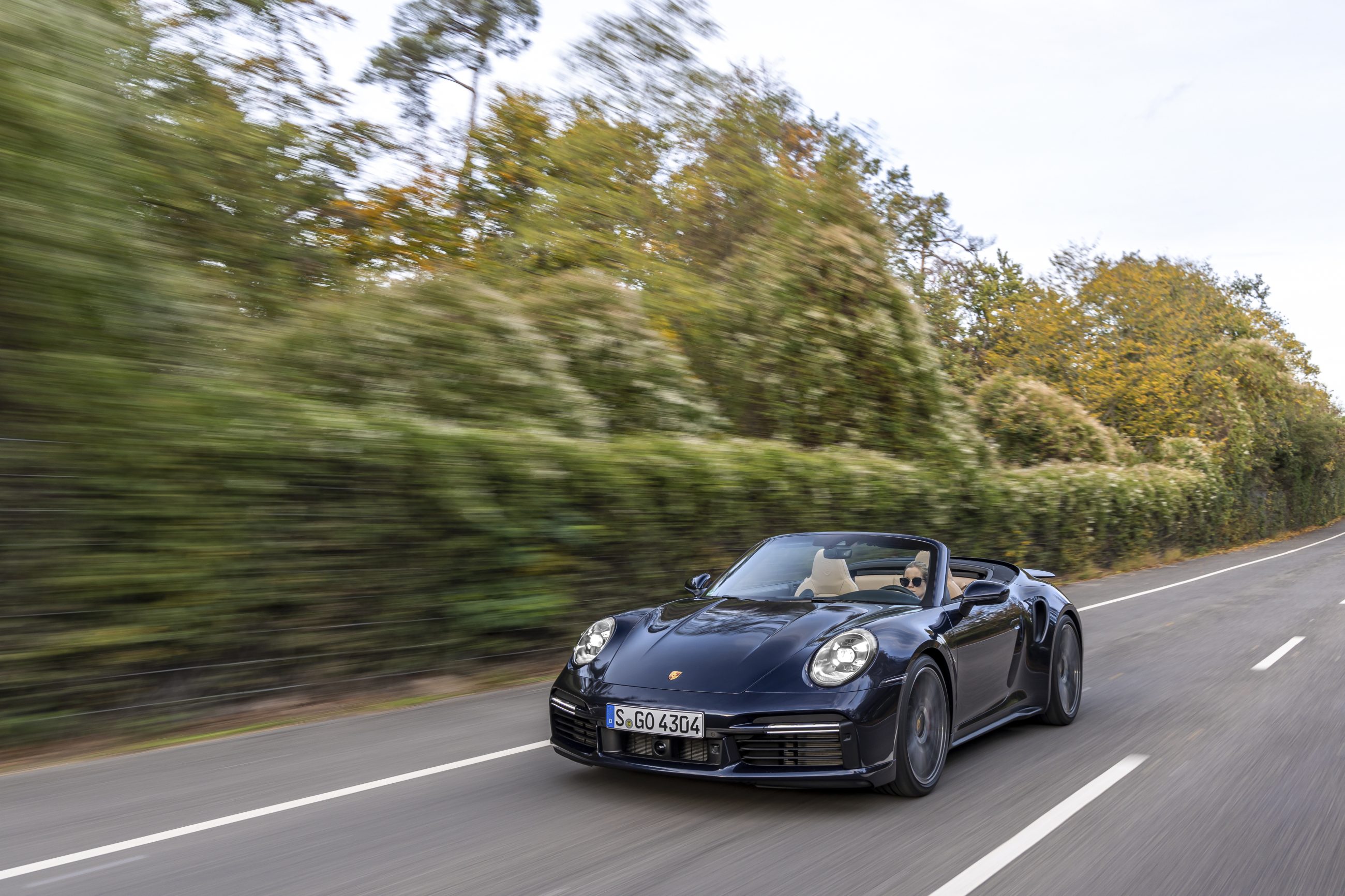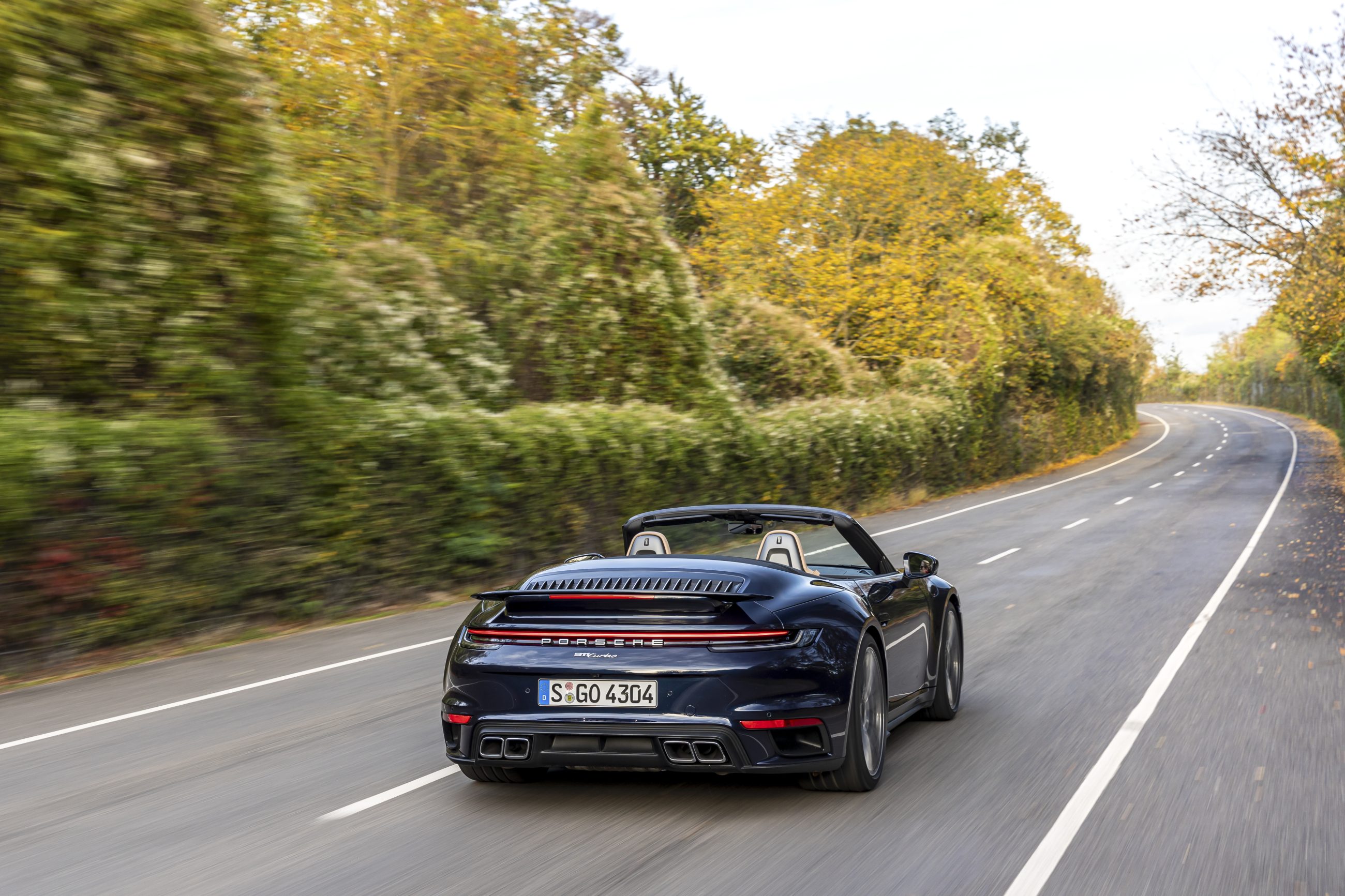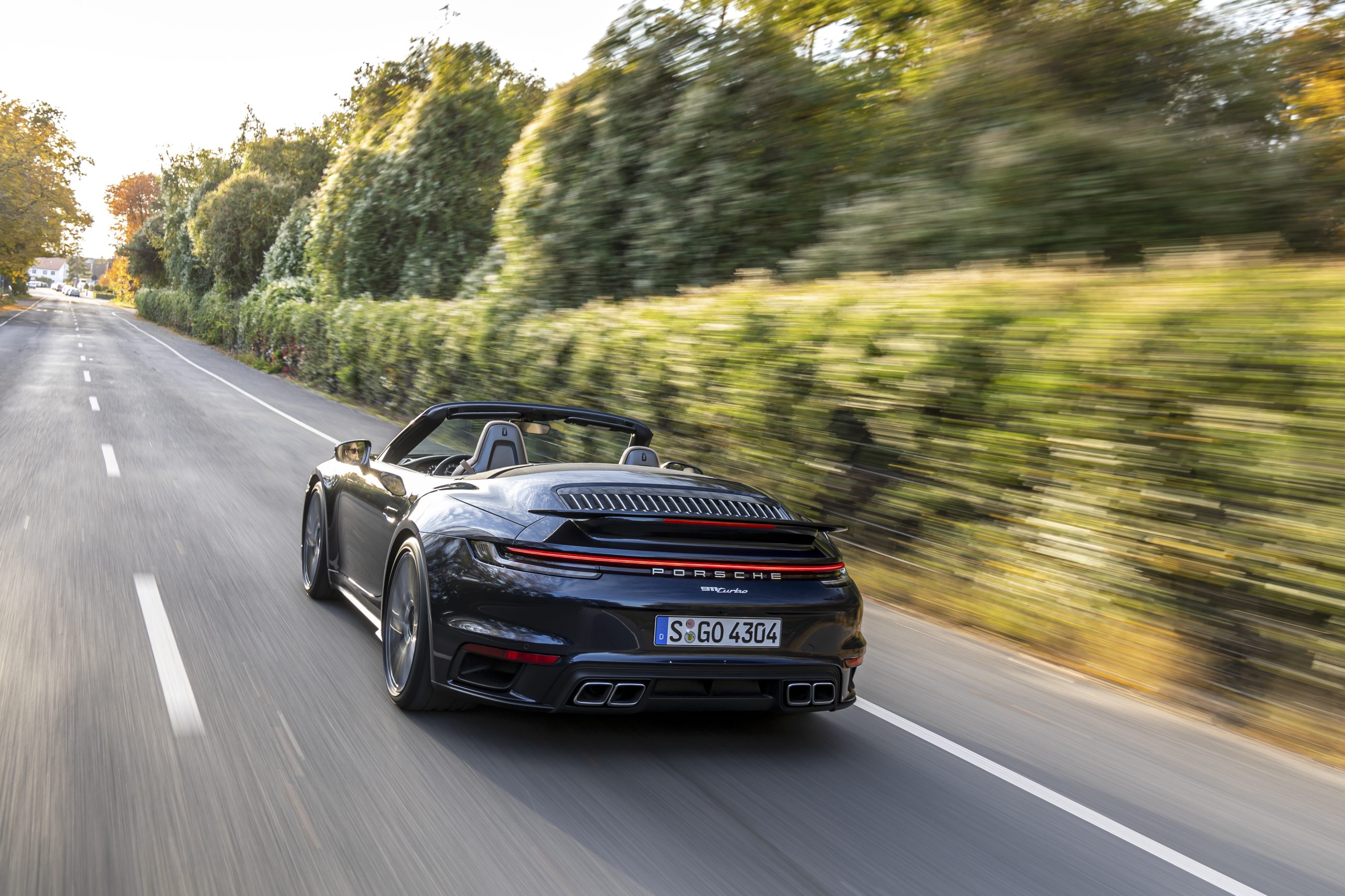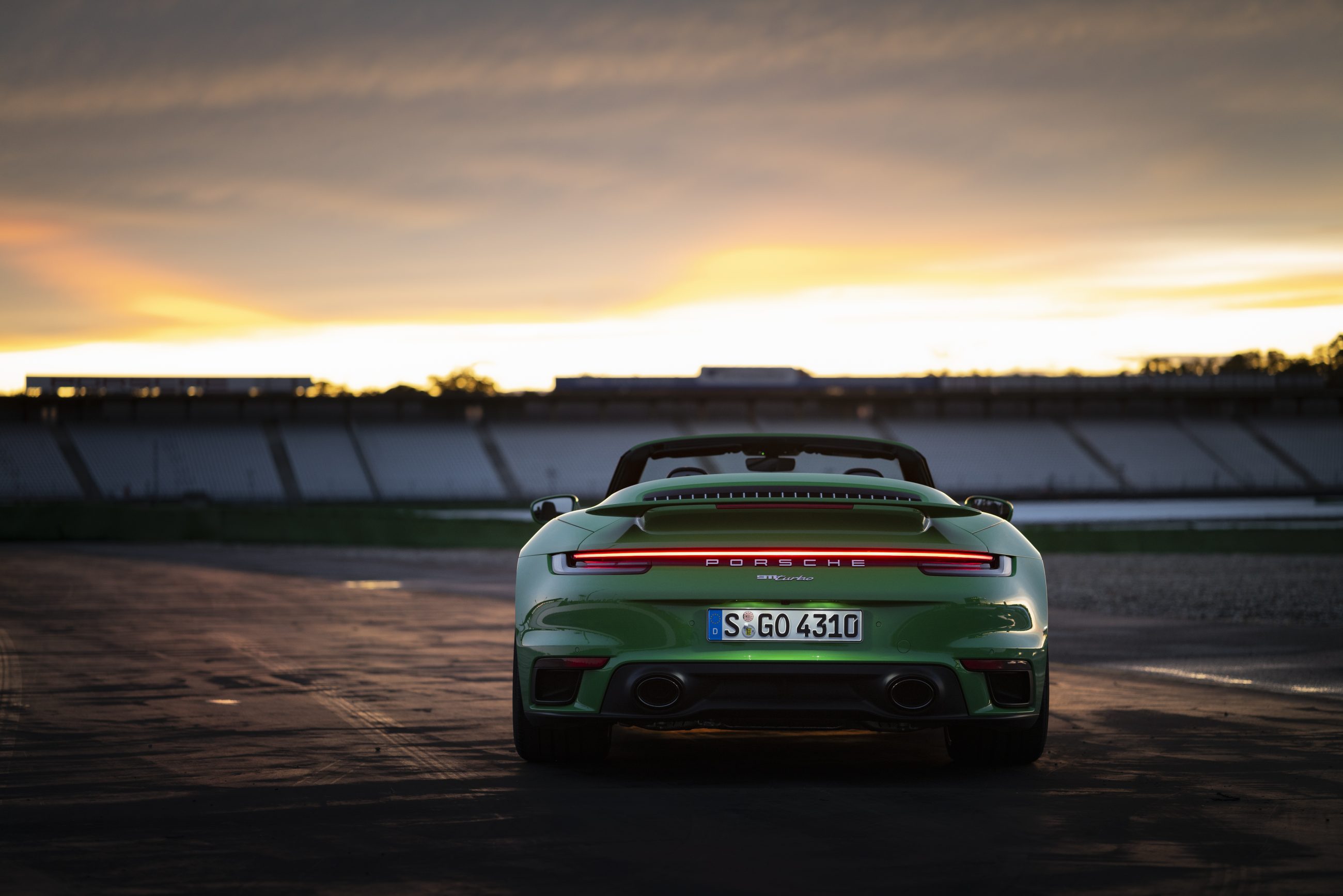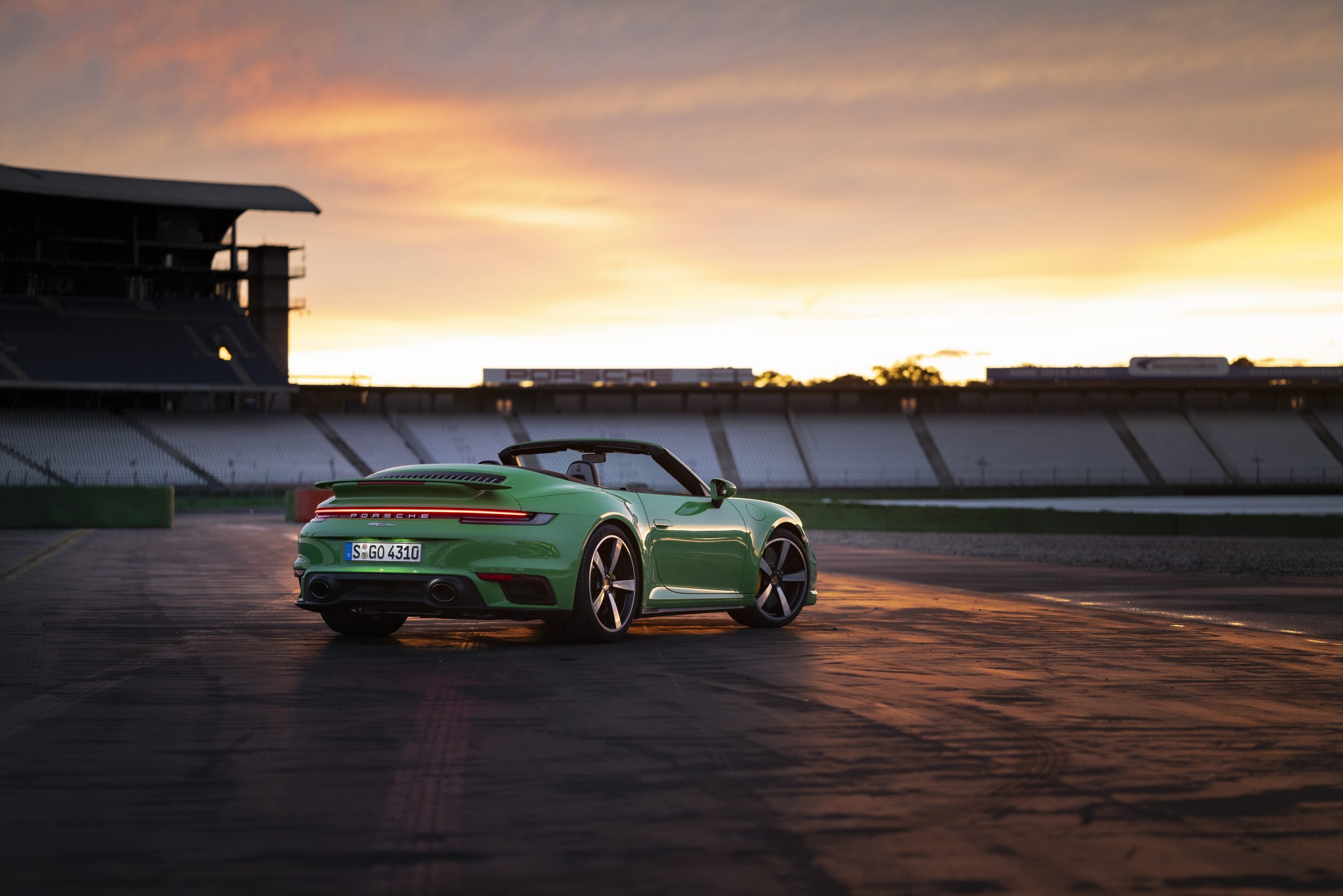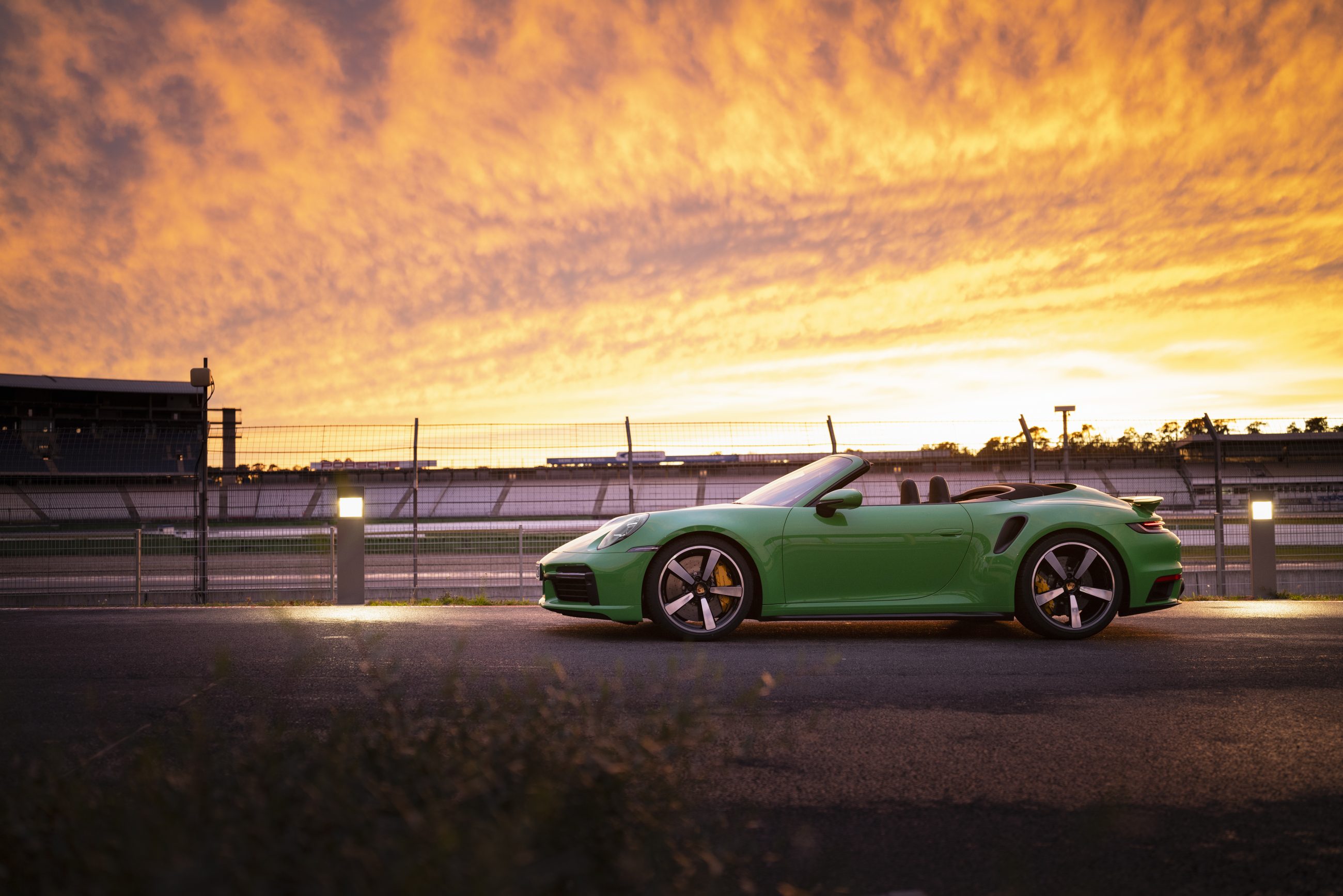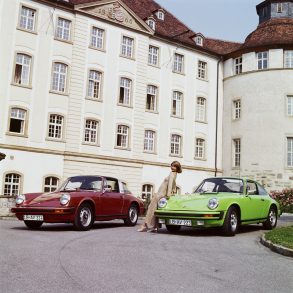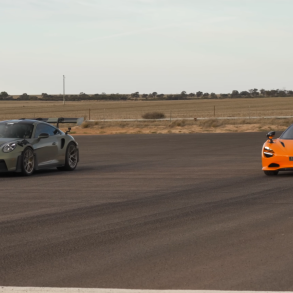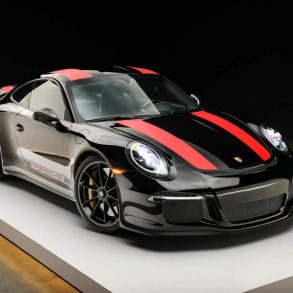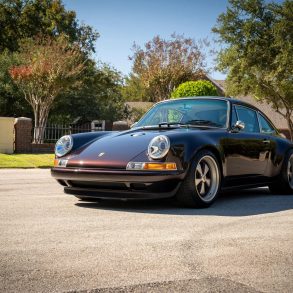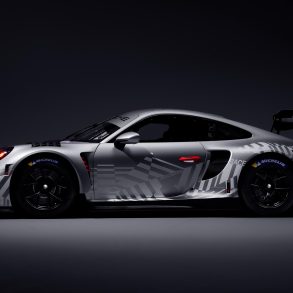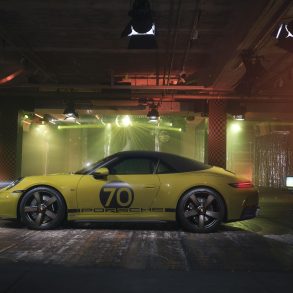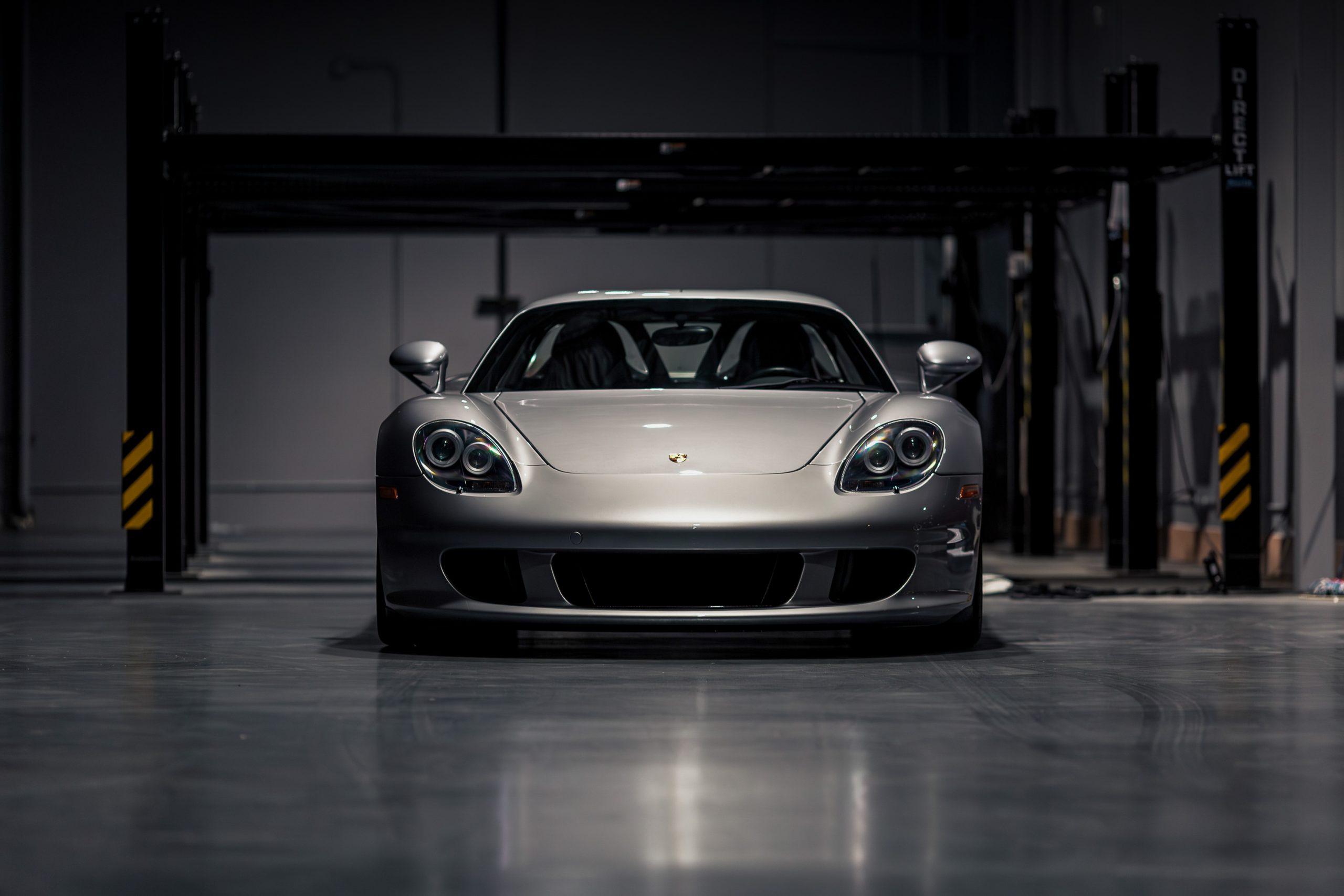2021 – 2025 Porsche 911 Turbo Cabriolet (992.1) – Reviews, Pricing, Specs & Buyers Guide
The 992.1 Porsche 911 Turbo Cabriolet is the rare open-top supercar that’s genuinely effortless to use every day. It combines volcanic pace with all-season traction, a fast, weather-proof soft top, and the click-and-go competence of PDK. Slotting beneath the Turbo S but sharing the same core hardware, the Turbo Cab delivers 572 hp, 553 lb-ft, PTM all-wheel drive, 8-speed PDK, and sophisticated active aerodynamics (PAA)—then lets you put the sky on silent mode in about 12 seconds. This guide covers its story, specs, performance, model-year changes, reviews, options that matter, and smart buyer tips.
Porsche revealed the 992-generation Turbo as the accessible flagship after launching the Turbo S in 2020. For model year 2021, the Turbo coupe and cabriolet arrived with the 3.745-liter twin-turbo flat-six, now at 572 hp and 553 lb-ft, driving all four wheels through PDK. Porsche’s U.S. release quoted 0–60 mph in 2.8 seconds for the Cabriolet (2.7 s coupe) and a 199-mph top track speed—numbers that match or exceed the 991.2 Turbo S from just a few years earlier.
The engineering brief didn’t change: the Turbo had to be supercar-fast without supercar compromises. The 992 platform widened the stance, increased tire, and integrated a far more capable Porsche Active Aerodynamics package—variable front spoiler and multi-position rear wing—to enhance stability when you actually use those speeds. In the most aggressive “Performance” position, Porsche says the system generates ~375 lb of downforce, a ~15% gain over the previous generation.
All 992 Cabriolets—Turbo included—use a multi-layer fabric top with magnesium panel bows and a lighter hydraulic drive. The open/close time is about 12 seconds and you can do it on the move up to ~31 mph; there’s also an electrically deployable wind deflector to keep cabin buffeting in check. The result is a roof you’ll actually use when weather changes mid-drive, and wind management that feels almost coupe-quiet at highway speeds.
Powertrain, Driveline & Chassis
Engine
- 3.745-liter twin-turbo flat-six with VTG turbos
- 572 hp @ 6,500 rpm, 553 lb-ft @ 2,250–4,500 rpm
- 7,200 rpm max engine speed; 8.7:1 compression; integrated dry-sump
Transmission & AWD
- 8-speed PDK dual-clutch (Turbo is PDK-only)
- Porsche Traction Management (PTM) all-wheel drive with a water-cooled, electronically controlled front clutch pack
Aero
- Porsche Active Aerodynamics (PAA): multi-stage front spoiler + active rear wing; up to ~375 lb downforce in “Performance” mode; new airbrake logic deploys the aero aggressively under high-speed braking.
Chassis & Wheels
- PASM adaptive dampers (PASM Sport –10 mm optional), rear-axle steering optional, PDCC active anti-roll optional
- Staggered 20/21-inch wheels with 255/35 ZR20 (F) and 315/30 ZR21 (R) tires
Brakes
- Standard iron brakes: 408 × 36 mm front (6-piston), 380 × 30 mm rear (4-piston)
- PCCB ceramics optional (420/390 mm on Turbo S; Turbo can be optioned depending on market)
Performance: Paper vs. Reality
From the factory, the 911 Turbo Cabriolet is rated 0–60 mph in 2.8 seconds and a 199-mph top speed. Independent testing of closely related variants shows Porsche’s conservatism: MotorTrend clocked a Turbo S Cabriolet at 2.4 s to 60 mph and 10.4 s quarter-mile, while Car and Driver has similar sub-2.5s runs for Turbo S Cab. For the non-S Turbo Cab, instrumented tests are rarer, but the coupe’s 2.4 s / 10.3 s @ 133 mph numbers suggest the Cabriolet trails by mere tenths when equally optioned and on similar rubber. Translation: even with the roof mechanism, the Turbo Cab is ferociously fast and repeatably so, in good weather or bad. What makes the difference is repeatability. PDK launches cleanly over and over, PTM shuffles torque before slip arrives, and PAA trims lift at speed (and even helps braking). The car feels unflustered where many convertibles feel vague.
Tech & Infotainment
- Wet Mode (range-wide): acoustic sensors in the front wheel housings detect spray thrown up by the tires, prompting a wet-optimized map that preconditions the stability, throttle, AWD and aero systems. It’s proactive—useful even after rain stops but the road is still damp.
- PCM 6.0 (Jan 24, 2022 update): brings a refreshed UI and Android Auto support to compatible 911s (CarPlay already present). If phone integration matters, MY2022+ cars are the safe bet.
Model-Year Updates (992.1 Turbo Cabriolet, 2021–2025)
- 2021 (launch year): Turbo Cabriolet debuts with 572 hp/553 lb-ft, PDK, PTM AWD, PASM, PAA, and factory claims of 2.8 s to 60 and 199 mph. Standard iron brakes are 408/380 mm; PCCB, PASM Sport, rear-steer, PDCC, front-axle lift, and Sport exhaust are optional.
- 2022: PCM 6.0 infotainment update adds Android Auto and UI refinements to eligible cars; powertrain unchanged.
- 2023–2025: Running refinements and package shuffles; core specification remains stable through the 992.1’s end. For context only, the 992.2 Turbo/Turbo S arrives later with hybridization (MY2026 deliveries), which also frames these 2021–2025 cars as the last pure-ICE Turbo Cabriolets.
Specifications (Quick Reference)
- Engine: 3.745-L twin-turbo flat-six (VTG) — 572 hp / 553 lb-ft
- Transmission: 8-speed PDK (only)
- Drivetrain: AWD (PTM), water-cooled multi-plate front clutch
- Aero: PAA variable front spoiler + active rear wing (≈375 lb max downforce in Performance mode)
- 0–60 mph (factory): 2.8 s (LC) | Top speed: 199 mph
- Wheels/Tires: 20/21 in; 255/35 ZR20 (F), 315/30 ZR21 (R)
- Brakes (iron): 408 × 36 mm F / 380 × 30 mm R; PCCB optional
- Roof: ~12 s operation, up to 31 mph, with electric wind deflector
How It Drives
Calm brutality, al fresco. Throttle pinned, there’s almost no lag—small, variable-geometry turbos and PDK keep the flat-six right in its fat torque band. Steering remains clean and precise despite the AWD choreography underneath, and rear-axle steering (if fitted) shrinks the car in hairpins while stabilizing high-speed sweepers. PASM in Normal is compliant; PASM Sport ties body motions down without turning it brittle on smooth roads. PDCC takes it further, flattening roll with minimal ride penalty. And when the sky opens up, Wet Mode plus PTM turn the Turbo Cab into the fastest car on a wet road—quietly, repeatably, safely.
On a good surface, the difference to a coupe or Turbo S Cab is largely academic away from a timing light. On an average road, with weather and traffic, the Turbo Cab’s bandwidth is its superpower: it’s almost always fast, almost always composed, and you get the theater of roof-down running when conditions allow. MotorTrend’s Turbo S Cab results merely underline how capable the open-top platform is in the 992 era.
Reception & Reviews: What the Press Said
- MotorTrend (Turbo S Cabriolet First Test): 2.4 s to 60, 10.4 s quarter; confirms the 992 Cabriolet chassis and aero give up little to the coupe even at the very top of the range.
- Car and Driver (Turbo S Cab drive): “mind-warping” straight-line pace and unflappable stability; the cabriolet’s speed is no longer a theoretical exercise.
- MotorTrend (Turbo Cabriolet first drive): Praised the 572-hp tune and the car’s everyday polish—“no compromises needed” is the recurring theme.
- Even when tests focused on the Turbo S, the takeaways apply: 992 Cabriolets are almost irritatingly complete, and the Turbo Cab sits in that sweet spot of nearly S-fast, meaningfully cheaper.
Options & Packages That Matter
- Sport Chrono (standard): steering-wheel mode switch, performance timers, Launch Control—key to the 0–60 claims.
- Rear-Axle Steering: makes the car feel smaller on tight roads and steadier at speed; highly recommended if you live in mountain or urban switchback country.
- PASM Sport (–10 mm): crisper body control; best for smooth, fast roads or occasional track time.
- PDCC: active roll control; gives that “ice-on-glass” calm over faster, bumpy sections.
- PCCB (ceramics): superb fade resistance and unsprung mass reduction; expensive to replace if damaged, but very durable for street use.
- Sport Exhaust: adds voice without long-haul drone (first time offered on 992 Turbo).
- Front-Axle Lift: sanity saver for steep driveways/ramps.
- Cab-specific comforts: ventilated seats and the electric wind deflector make top-down seasons longer.
Buying Guide (Used)
- Roof system health. Cycle the top repeatedly (you can do this while rolling slowly). Operation should be smooth and quiet, the deck should sit flush, and seals should be watertight after a wash. The mechanism is robust, but it’s complex—perfect function is table stakes.
- Aero & underbody. Inspect the front spoiler elements (part of PAA) and check the rear wing for smooth actuation; PAA faults are rare but expensive.
- Brakes & wheels. The standard 408/380 mm iron setup is stout; look for rotor lip ridges and any pedal pulsation. PCCB rotors last a long time on the road but are pricey—inspect faces carefully. 20/21-inch wheels attract curb rash; check inner barrels and the 315-section rear tire shoulders for inner wear.
- Electronics & PCM. If Android Auto matters, prefer MY2022+ or verify PCM 6.0 software on earlier cars.
- Options stack. Character and residuals move with rear-steer, PASM Sport, PDCC, Sport exhaust, front-axle lift, and (for some buyers) PCCB. Decide how you’ll drive and choose accordingly.
- Provenance. Seek a clean service history, unmolested ECU (for warranty), and recent tires aligned properly; the car is robust if maintained.
Ownership Experience & Verdict
Driven gently, the Turbo Cab is as docile as a Carrera: PASM Normal is supple, cabin noise is low with the roof up, and the frunk plus rear shelf handle weekender luggage. Driven hard, the PDK + PTM powertrain launches you into warp speed with zero drama. In shoulder seasons or rain, Wet Mode unlocks a bigger slice of the performance, more of the year—exactly what a real-world “everyday supercar” should do.
The 992.1 911 Turbo Cabriolet is the open-air 911 for people who want everything: S-adjacent speed, four-season traction, a quick, quiet roof, and a chassis that feels carved from granite. Spec rear-steer and (if your roads are smooth) PASM Sport; add PDCC if you chase fast, bumpy backroads; pick PCCB if you habitually cook brakes; and make sure the roof and PAA bits are perfect. Do that, and you’ll own the rare 200-mph convertible that can demolish a runway, shrug off a storm, and idle through traffic—without ever feeling like a compromise.
What We Said At Launch
All Porsche 911s are turbocharged these days but the Turbo model is something special. It gets the twin-turbo 3.7-liter flat six with tons of power and a huge $33,000 savings over the Turbo S. It would be a disservice to call this new Turbo Cabriolet a “lesser” car than the Turbo S Cabriolet , but it does have less in most departments. Less power at 573 HP. Less features compared to the jam-packed Turbo S.
Most importantly, less money required to put one in your garage. This also is not to say that the new Turbo isn’t anything short of a monster. Thanks to an output of 573 hp, marking an increase of 32 hp over the predecessor, the new 911 Turbo Cabriolet accelerates from 0 to 60 mph in 2.8 seconds (0.2 seconds faster than before) .
The Turbo Cabriolet handles like a coupe. It will corner like it was on rails with Porsche Torque Management (PTM) all-wheel-drive, and it will still hit a 199 mph top speed. Porsche themselves, in their press release, points out another important fact about the new Turbo Cabriolet: It matches, or exceeds, the packaging, performance, and technology of the Type 991 911 Turbo S.
An 8-speed PDK dual-clutch transmission is the only available option for the Turbo. However, almost all of the technology packages that are built into the Turbo S are available as options for the Turbo, so you can pick and choose the specific items you want. Orders for the new Porsche Type 992 911 Turbo are being accepted now, and Porsche is hoping to have cars in owners’ hands in the Fall.
Car and Driver: Aside from the explosive acceleration, the 911 Turbo exhibits insane levels of cornering grip and strong brakes to boot, making it a true performance powerhouse. The cabriolet variants are slightly heavier than the coupe
Videos & Reviews
Pictures
Press Release
Atlanta, Georgia. Since its introduction over 45 years ago, the Porsche 911 Turbo has balanced everyday usability with exhilarating performance. Following the recent introduction of the 2021 911 Turbo S, the 2021 911 Turbo Coupe and Cabriolet are now making their debut.
Thanks to an output of 572 hp (427 kW), marking an increase of 32 hp over the predecessor, the new 911 Turbo accelerates from 0 to 60 mph in 2.7 seconds (0.2 seconds faster than before) while the new 911 Turbo Cabriolet takes 2.8 seconds (also 0.2 seconds faster) The acceleration, power output and torque (553 lb.-ft.) of the new 911 Turbo are on the level of the previous 2019 911 Turbo S.
Like the 2021 911 Turbo S, the twin-turbo boxer engine in the 911 Turbo models is mated to a standard eight-speed PDK transmission with Turbo-specific internals and calibration. The top track speed of the new 911 Turbo models is 198 mph. New options such as a Sport and Lightweight package, Sport Suspension with a lower ride height and Sport Exhaust system, first introduced for the 911 Turbo S, are also available for the 911 Turbo for the first time, providing an even higher degree of customization than ever before.
The 2021 911 Turbo models follow in prestigious footsteps: the 911 Turbo has been the ultimate intersection of performance and luxury within the 911 model line since 1975. The latest generation of 911 Turbo is more than twice as powerful as the original 930 Turbo, which featured a three-liter, six-cylinder boxer engine, single turbocharger and an output of up to 260 PS, depending on the market.
Like the recently introduced 2021 911 Turbo S, the six-cylinder boxer engine in the new 911 Turbo has a displacement of 3,745 cc and now features symmetrical VTG turbochargers with electrically controlled bypass valves. In conjunction with the redesigned charge air cooling system and the use of piezo fuel injectors, this improves throttle response, performance, torque delivery and the free revving nature of the engine. In the Turbo models, this engine makes 572 hp. Complementing the increase in power, the chassis has been tuned to offer an even greater level of performance. Adopting the changes implemented on the new 911 Turbo S earlier this year, steering response and precision on the new 911 Turbo models have been further improved thanks to an additional 1.65 inches of front track width and the new 20-inch 255/35 tires (up from 245/35 previously). Also shared with the 2021 911 Turbo S, the Porsche Traction Management (PTM) active all-wheel drive system in the 911 Turbo is able to transfer even more power to the front wheels than before. Traction at the rear axle, which is equipped with rear-axle steering as standard, is increased even further by 0.39 inches of added track width compared to the last 911 Turbo, as well as 315/30 tires on 21-inch wheels (305/30 R 20 previously). The revamped brake system is even larger than on the last 911 Turbo and can be recognized by the red fixed calipers. The front cast iron brake rotors now measure 408 millimeters in diameter (28 mm larger than the previous 911 Turbo) and are 36 millimeters thick (plus 2 mm). The rear axle features 380-millimeter brake rotors that are 30 millimeters thick. Porsche Ceramic Composite Brakes (PCCB), standard on the 911 Turbo S, with 10-piston front calipers, are available as an option.
A Sport Exhaust system that was introduced on the 2021 911 Turbo S is also optionally available for the 911 Turbo for the very first time. Two different suspension options are also new: while the standard PASM suspension offers a greater spread between agility and ride comfort than before, the particularly performance oriented, electronically controlled PASM Sport Suspension with a 0.39 inch (10 mm) lower ride height compared to the standard suspension benefits the agility of the new 911 Turbo even further with a set-up aimed at further enhancing driving dynamics. Porsche Dynamic Chassis Control (PDCC), which uses active anti-roll stabilization, is available as an option for the 911 Turbo models.
The muscular design of the 911 Turbo reflects the significant increase in power and performance of the new generation. Shared with the 2021 911 Turbo S, the body of the new 911 Turbo models is 1.8 inches wider than the predecessor at the front fenders to accommodate the increase in track width and tire size compared to the previous model. The new front luggage compartment lid featuring a striking recess in the center underlines the performance-focused character. LED headlights with PDLS Plus are fitted as standard. At the rear axle, the body is now 0.78 inches wider than the previous generation 911 Turbo (991), also to accommodate wider track and tires. Other distinguishing features of the new 911 Turbo are the enhanced adaptive aerodynamics with controlled cooling air flaps at the front, a larger active front spoiler and the significantly increased size of the active rear spoiler. The air intakes on the rear side panels, characteristic for the 911 Turbo, now draw in process air rather than cooling air. The charge air coolers are now positioned directly in the air stream under the rear decklid. The continuous light bar with LED tail lights as well as the new louvered rear decklid grille with silver trim strips round off the design of the rear end.
The appearance and performance-focused character of the vehicle can be additionally enhanced by the optional Lightweight package and Sport package. The Lightweight package for the coupe reduces the vehicle’s weight by about 66 pounds. Full Bucket seats, the deletion of the rear seats and reduced sound insulation contribute to the weight savings and allow the exhaust note to enter the cabin more intensely. The Sport package encompasses all the elements of the SportDesign package as well as additional applications in Black, carbon fiber elements and Exclusive Design clear taillights.
The basic elements of the 911 Turbo interior correspond to those of the current 911 Carrera models with Porsche Advanced Cockpit and Direct Touch Control. The 10.9-inch Porsche Communication Management (PCM) center screen can be operated quickly. The extensive list of standard equipment includes electrically adjustable 14-way Sport seats, the Sport Chrono package, a GT Sport steering wheel with shift paddles and mode switch as well as the BOSE® Surround Sound System. Numerous options are available, including Porsche InnoDrive with adaptive cruise control, Lane Keep Assist with traffic sign recognition, Night Vision Assist, Surround View and a Burmester® High-End Surround Sound System.
The 2021 911 Turbo models are available to order now and are expected to reach U.S. dealers by early 2021. MSRP is $170,800 for the 911 Turbo Coupe and $183,600 for the 911 Turbo Cabriolet, both not including the $1,350 delivery, processing and handling fee.


